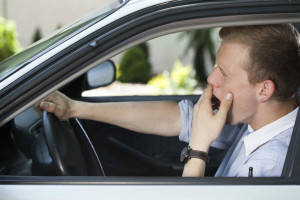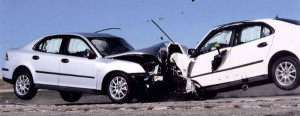Accident Claims Involving Head On Collisions
Head On Collisions
A head-on collision is one of the most dangerous types of accidents. While head-on accidents account for only two percent of all motor vehicle crashes, they account for more than 10 percent of vehicle fatalities. While even slow-speed head-on crashes can cause serious injury, those at high rates of speed are often fatal.
Quick Reference Links
- Common Causes and Injuries--Head-On Crashes
- Types of Injuries Associated With Head-On Crashes
- Determining Liability in Head On Collisions
Common Causes and Injuries--Head-On Crashes
 Many head-on crashes are caused by driver fatigue or falling asleep at the wheel.
Many head-on crashes are caused by driver fatigue or falling asleep at the wheel.
At night, it is difficult to determine if an oncoming car is veering into your lane. Many victims of head-on crashes are seriously injured or die when another driver falls asleep and swerves into oncoming traffic. Another common cause of head-on collisions is cell phone usage, particularly texting. Faulty traffic lights or signs, intoxicated drivers and swerving to avoid a previous accident are all common causes of head-on crashes.
Older drivers and very young drivers are more likely to make crucial driving errors that could lead to a head-on crash. Further, many drivers are involved in a crash when they attempt what are known as "defensive maneuvers." This complicated pattern occurs when an oncoming driver swerves into your lane and you swerve into the opposite lane to avoid the crash. Unfortunately, this can actually lead to a crash with another vehicle.
Types of Injuries Associated With Head-On Crashes
Many victims of head-on crashes suffer very serious injuries. These injuries may include:
- Head trauma. One of the most devastating types of injuries in a car accident, traumatic brain injuries can cause lifelong complications.
- Paralysis. Spinal cord injuries can lead to partial or complete paralysis. This often entails significant and lifelong changes in the victim's ability to support himself or herself.
- Whiplash injuries. In some cases, head-on crashes, like rear-end crashes, can lead to whiplash injuries. These are injuries to the soft tissues of the neck, head, back and shoulders that can lead to long-term pain.
- Internal injuries. Many head-on crashes result in serious internal injuries that require surgery. These injuries may take a great deal of time to heal and can significantly affect the victim's ability to work.
- Broken bones. Broken bones are common injuries in head-on crashes and can lead to long recuperation periods.
Many injuries sustained in head-on crashes result in months or years of recovery. Some victims never fully recover or regain their ability to work and take care of themselves and their families.
Determining Liability in Head On Collisions
 Liability in head-on collisions is often determined by evidence collected from the crash site. This may include witness statements and physical evidence from the crash itself. The victim of the crash must show that he or she was injured in order to collect damages. This may be accomplished by showing medical bills for treatment or therapy, property damage repair estimates and other documentation. The victim will also want to show police reports and witness statements where available as well as photographs and other documentation of the facts of the accident.
Liability in head-on collisions is often determined by evidence collected from the crash site. This may include witness statements and physical evidence from the crash itself. The victim of the crash must show that he or she was injured in order to collect damages. This may be accomplished by showing medical bills for treatment or therapy, property damage repair estimates and other documentation. The victim will also want to show police reports and witness statements where available as well as photographs and other documentation of the facts of the accident.
In many cases, the at-fault driver's insurance company will be paying the bill. In other cases, the insurance company may deny the claim or there may be mitigating circumstances that cause conflict over the amount the driver owes. In that case, you may need the help of a personal injury attorney. The personal injury lawyers at David Law Group, P.A. may be able to help you recover compensation for your medical expenses, pain and suffering, lost wages and other costs associated with the accident. Contact us today at 800.360.7015 for a free, no obligation consultation about your case.

